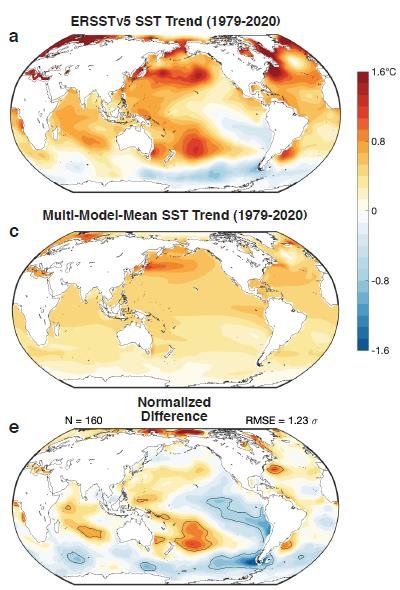“If it [a scientific hypothesis] disagrees with experiment, it’s WRONG.” – Nobel Prize winner Richard Feynman

An earlier post of mine described how a group of prestigious U.S. climate scientists recently admitted that some climate models run too hot, greatly exaggerating future global warming. Now another group has published a research paper revealing that a whole ensemble of models is unable to reproduce observed sea surface temperature trends in the Pacific and Southern Oceans since 1979.
The observed trends include enhanced warming in the Indo-Pacific Warm Pool – a large body of water near Indonesia where sea surface temperatures exceed 28 degrees Celsius (82 degrees Fahrenheit) year-round – as well as slight cooling in the eastern equatorial Pacific, and cooling in the Southern Ocean.
Climate models predict exactly opposite effects in all three regions, as illustrated in the following figure. The top panel depicts the global trend in measured sea surface temperatures (SSTs) from 1979 to 2020, while the middle panel depicts the multimodel mean of hindcasted temperatures over the same period from a large 598-member ensemble, based on 16 different models and various possible CO2 emissions scenarios ranging from low (SSP2-4.5) to high (RCP8.5) emissions. The bottom panel shows the difference.

You can see that the difference between observed and modeled temperatures is indeed marked. Considerable warming in the Indo-Pacific Warm Pool and the western Pacific, together with cooling in the eastern Pacific and Southern Ocean, are absent from the model simulations. The researchers found that sea-level pressure trends showed the same difference. The differences are especially pronounced for the Indo-Pacific Warm Pool.
The contributions of the individual model ensemble members to several key climate indices is illustrated in the figure below, where the letters A to P denote the 16 model types and the horizontal lines show the range of actual observed trends.

The top panel shows the so-called Pacific SST gradient, or difference between western and eastern Pacific; the center panel shows the ratio of Indo-Pacific Warm Pool warming to tropical mean warming; and the bottom panel portrays the Southern Ocean SST. All indices are calculated as a relative rate of warming per degree Celsius of tropical mean SST change. It is clear that the researchers’ findings hold across all members of the ensemble.
The results suggest that computer climate models have systematic biases in the transient response of ocean temperature patterns to any anthropogenic forcing, say the research authors. That’s because the contribution of natural variability to multidecadal trends is thought to be small in the Indo-Pacific region.
To determine whether the difference between observations and models comes from internal climate variability or from climate forcing not captured by the models, the researchers conducted a signal-to-noise maximizing pattern analysis. This entails maximizing the signal-to-noise ratio in global temperature patterns, where the signal is defined as the difference between observations and the multimodel mean on 5-year and longer timescales, and the noise consists of inter-model differences, inter-ensemble-member differences, and less-than-5-year variability. The chosen ensemble had 160 members.
As seen in the next figure, the leading pattern from this analysis (Difference Pattern 1) shows significant discrepancies between observations and models, similar to the difference panel designated “e” in the first figure above. Lack of any difference would appear as a colorless pattern. Only one of the 598 ensemble members came anywhere close to matching the observed trend in this pattern, indicating that the models are the problem, not a misunderstanding of natural variability.

The second pattern (Difference Pattern 2), which focuses on the northern Pacific and Atlantic Oceans, also shows an appreciable difference between models and observations. The research team found that only a handful of ensemble members could reproduce this pattern. They noted that the model that most closely matched the trend in Pattern 1 was furthest from reproducing the Pattern 2 trend.
Previously proposed explanations for the differences seen between observed and modeled trends in sea surface temperatures include systematic biases in the transient response to climate forcing, and model biases in the representation of multidecadal natural variability.
However, the paper’s authors conclude it is extremely unlikely that the trend discrepancies result entirely from internal variability, such as the anomalous return to warming during the recent cool phase of the PDO (Pacific Decadal Oscillation) as proposed by other researchers. The authors say that the large difference in the Warm Pool warming rate between models and observations (“b” in the second figure above) is particularly hard to explain by natural variability.
They suggest that multidecadal variability of both tropical and subtropical sea surface temperatures is much too weak in climate models. The authors suggest that damping feedbacks in response to Warm Pool warming may be too strong in the models, which would reduce both the modeled warming rate and the modeled amplitude of multidecadal variability.
Author

Retired physicist Dr. Ralph B. Alexander is the author of Global Warming False Alarm and Science Under Attack: The Age of Unreason. He blogs at his website Science Under Attack.
With a PhD in physics from the University of Oxford, he is also the author of numerous scientific papers and reports on complex technical issues. His thesis research in the interdisciplinary area of ion-solid interactions reflected his interest in a wide range of scientific topics.
Dr. Alexander has been a researcher at major laboratories in Europe and Australia, a professor at Wayne State University in Detroit, the co-founder of an entrepreneurial materials company, and a market analyst in environmentally friendly materials for a small consulting firm.
Alexander is a USA signee of the CLINTEL World Climate Declaration.
